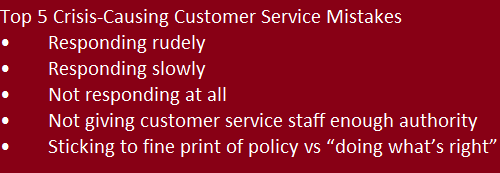The front desk person at a financial services firm I visited some time ago had a marvelous title on her nameplate, “Director of First Impressions.”
She knew that she was in a make or break position for her firm, that initial opinions of new clients may well be influenced by how she treated them – even if they were having a bad day. In fact, especially when they were having a bad day.

Unfortunately, at too many organizations, the people on the “front desk” of their online operations don’t understand this. And you know the phone call someone in the C-Suite ends up making, eventually? It’s to a firm like ours, and what we hear is, ““We have horrible reviews, they’re hurting our reputation and our organization, can you help?”
Of course we say, “yes” (for a price), but the fact is most such calls for assistance could have been avoided completely. These are the five top crisis-causing mistakes in online customer service:
- Responding rudely. If you can’t treat customers/clients with compassion and consideration (even when they’re cranky), take yourself off of customer service for the day.
- Responding slowly. Going into the third decade of the 21st Century, customers/clients expect responses no later than 24 hours from when they submitted a concern/complaint, or else they feel like they’re unimportant and/or being ignored.
- Not responding at all. Nothing says “we don’t care” like ignoring a customer. This includes the infamous “customer service phone numbers than cut you off frequently.”
- Not giving customer service staff sufficient authority, the authority to resolve matters “on the spot” without escalating. Often requiring the customer, who’s already feeling slighted in some way, to re-explain his/her whole issue, with attendant misunderstandings (particularly when a customer service rep’s first language is not the same as the customer’s).
- Sticking to the fine print of policy vs “doing what’s right.” Policies never cover all contingencies. Common sense should dictate “what’s right” in such situations. And erring on the side of the customer, particularly when small amounts are involved, is less expensive than the loss of business caused by bad reviews.
I had a personal example of the latter point recently — a company that sent me the entirely wrong product and then wanted me to pay return postage because “that’s their policy on returns.” After they wouldn’t listen to polite reason, I posted a quick negative review and a BBB complaint. They changed their mind and offered me a full refund plus a free product of my choice for the trouble. The more senior customer service rep who took on my case expressed particular concern about my reviews and asked if I would consider amending the reviews, and I said I would once I’d received the replacement product I wanted and was satisfied with it. All of this was entirely preventable and not all consumers are willing to be as cooperative as I was – but many consumers now know how to file online bad reviews and complaints.

Maybe it’s time to revisit your Customer Service policies and practices to ensure they’re in keeping with today’s demands? And remember to train and re-train personnel on the front lines if you want them to remember how to prevent crises!
Jonathan Bernstein
[email protected]
www.bernsteincrisismanagement.com
